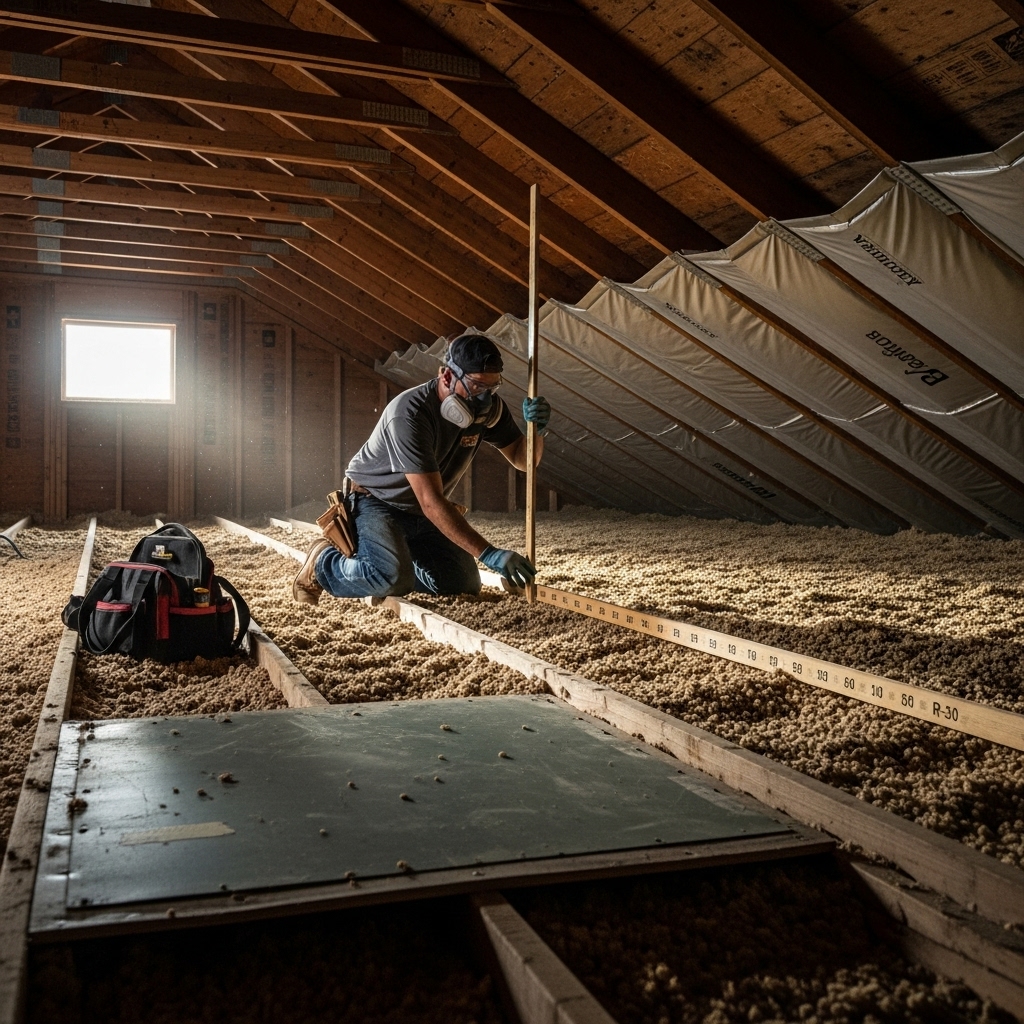Setting the right thermal target for your attic is essential to achieving steady temperatures and efficient operation of your heating and cooling equipment. In Los Angeles, many homes aim for R-30 as a practical baseline that balances performance with constructability in typical attics. This guide explains what R-value means, how to reach an effective R-30 in real-world conditions, and which details matter most for long-term comfort and durability. As you plan, remember that the path to a successful upgrade involves more than depth—it includes air sealing, ventilation, and careful detailing around fixtures and eaves. If you’re early in the process, consider speaking with a professional who treats attic insulation as a coordinated system rather than a stand-alone product.
R-30 is not a magic number; it’s a performance target that must be supported by workmanship and complementary measures. The difference between a nominal R-30 and an effective R-30 can be dramatic depending on air leakage, thermal bridging, and coverage uniformity.
What R-Value Really Means
R-value is a measure of thermal resistance. In practice, it describes how well a layer of material resists heat flow. However, the published R-value assumes laboratory conditions, uniform thickness, and no air movement through or around the material. In an attic, gaps, compression, wind-washing at the eaves, and thermal bridges at framing all reduce real-world performance. That’s why an “R-30” installation can feel different from house to house—the detailing makes the difference.
To achieve an effective R-30, aim for continuous, uncompressed coverage, strong air sealing at the attic floor, and controlled ventilation above the insulation layer. A builder or contractor who understands these interactions will deliver results that match expectations more closely.
Los Angeles Climate Considerations
LA’s blend of sunny days, cool nights, marine-layer mornings, and microclimates means your attic sees wide temperature swings over the year. Roof decks can get hot in summer afternoons, while night temperatures drop quickly in canyon or hillside areas. Uncontrolled airflow through the attic floor intensifies these swings inside your home. An R-30 strategy that prioritizes air sealing and proper eave detailing helps stabilize indoor conditions and reduce the burden on your HVAC system.
Material Paths to R-30
Several material combinations can achieve an R-30 target, each with pros and best-use scenarios:
- Blown-in fiberglass: Provides uniform coverage in open attics, especially when installers pay attention to eaves and around truss webs.
- Cellulose: Fills irregular voids and offers sound attenuation; dense fibers can resist some air movement within the layer when properly installed.
- Batt systems: Work in accessible areas and knee walls; success depends on precise fitting around obstructions and thorough air sealing.
- Roofline foam (unvented scenarios): Combines air sealing and insulation at the roof deck; requires experienced crews and attention to ventilation strategy for the rest of the home.
- Hybrid approaches: Air seal the attic floor, then use blown-in materials for broad coverage while applying batts or rigid baffles in targeted locations.
Choose a path based on your attic’s geometry, access, and whether you have recessed lighting, chimneys, or complex duct layouts. The best solution is the one that integrates easily with air sealing and ventilation measures.
Air Sealing: The Foundation of Effective R-30
Air sealing reduces heat transfer driven by air movement, which can overwhelm insulation layers during hot afternoons or cool nights. Focus areas include top plates, plumbing stacks, wire penetrations, dropped soffits, open chases, and the attic hatch. For recessed lights, use approved covers or maintain required clearances, sealing around the housing as allowed. When you slow air leakage, your R-30 layer works as intended and room-to-room temperatures even out.
Ventilation and Eave Detailing
To protect insulation performance, maintain clear intake at soffits with properly installed baffles. This prevents wind-washing, which can scour away thermal effectiveness at the edges of your attic. Balanced exhaust removes excess heat and moisture. In LA’s sunny climate, proper ventilation keeps roof decks closer to ambient conditions, which supports shingle longevity and reduces the load on your HVAC system.
Treating Ducts, Hatches, and Transitions
An R-30 attic reaches its potential when ducts are sealed, supported, and insulated, limiting losses into the attic space. The attic hatch is another critical area—install a gasketed, insulated cover and ensure it closes securely. Pay attention to transitions between different attic zones, such as knee walls or partitioned bays, where continuity of the air and thermal barriers can be interrupted.
Uniform Coverage and Installation Quality
Even a high-quality material underperforms when coverage is inconsistent. Installers should ensure proper depth at eaves, around framing, and near obstructions. They should avoid compressing material by walking through coverage areas without catwalks and should protect low-clearance edges from wind-washing. Look for crews that document coverage with depth markers and photos.
When R-30 Is a Step in a Larger Plan
Some homes choose R-30 as part of a phased improvement plan. For instance, you might start with air sealing and a clean R-30 installation today, then address duct improvements or attic ventilation upgrades shortly thereafter. A staged approach can be effective as long as each step is designed to complement the next and documentation is kept for future work.
Moisture, Fire Safety, and Special Conditions
Good attic strategies consider moisture pathways and ignition sources. Keep required clearances around flues and combustible fixtures, and use approved materials where heat is present. For coastal and marine-layer neighborhoods, confirm that ventilation pathways are clear and that eave details resist wind-driven moisture. In areas with wildfire concerns, discuss ember resistance at vents and material properties with your contractor.
Quality Control and Verification
Ask for a post-install walkthrough with photos showing air sealing locations, coverage depth, and eave detailing. If available, basic diagnostic checks—such as pressure or smoke tests around known leakage points—can validate air sealing work. Documentation ensures that future electrical or roof projects can proceed without compromising your R-30 attic.
Common Mistakes That Undermine R-30
Even well-intended projects can miss the mark. Watch out for:
- Skipping air sealing, which allows hot or cool air to bypass insulation.
- Ignoring eaves, leading to wind-washing and edge losses.
- Compressing insulation by storing items directly on the attic floor.
- Neglecting the attic hatch, leaving a large, uninsulated opening.
- Overlooking ducts, which can leak and negate insulation gains.
Addressing these details increases the likelihood that your R-30 installation performs close to its labeled value in real conditions.
DIY vs. Professional Installation
Some homeowners can handle limited air sealing or small areas of blown-in or batt installation. However, professional crews bring experience with safety, containment, eave detailing, and complex attic geometries. They also anticipate interactions among insulation, ventilation, and mechanical systems. If your attic has multiple penetrations, recessed fixtures, or tight access, professional help is often the faster and more reliable path to an effective R-30.
Frequently Asked Questions
Q: Is R-30 enough for every Los Angeles home?
A: R-30 is a common target and a solid baseline for many attics. The best level for you depends on your home’s design, microclimate, HVAC use, and the quality of air sealing and ventilation. A balanced approach often delivers better comfort than depth alone.
Q: Do I need to remove old insulation to reach R-30?
A: Not necessarily. If existing material is clean and dry, it may be augmented. If it’s contaminated, compressed, or hides major air leaks, removal can enable better sealing and more reliable coverage.
Q: How does attic ventilation affect R-30 performance?
A: Balanced ventilation supports consistent attic conditions, limiting heat buildup and preventing wind-washing at the eaves. Both help your insulation perform closer to its intended value.
Q: Can R-30 help with noise?
A: Yes. Uniform coverage, especially with dense materials, can reduce sound transmission from outside and between rooms.
Q: What about recessed lights and chimneys?
A: They require safe clearances and carefully sealed transitions. Approved covers and correct detailing prevent heat risks and air leakage.
Q: Will an R-30 upgrade affect my HVAC?
A: Often, yes. A tighter, better-insulated attic reduces temperature swings and can lead to more stable HVAC operation, potentially lowering runtime and improving comfort.
Maintenance and Future-Proofing
Once your R-30 attic is in place, protect it. Keep soffit vents clear, verify that storage platforms do not compress insulation, and maintain a tight attic hatch. Whenever you add lighting, run new wires, or change ducts, coordinate with a professional to preserve the air and thermal barriers.
Plan Your Path to an Effective R-30
R-30 can be a smart, balanced target for Los Angeles, but success depends on details: air sealing, eave protection, ventilation balance, and careful work around fixtures. Treat your attic as part of a system and document each step for future projects. When you’re ready to move from planning to action, speak with a professional who integrates diagnostics, clean installation practices, and thorough aftercare. To align goals and methods, explore expert approaches to attic insulation and ask how they will verify coverage, airflow, and safety. With the right plan, your home will feel calmer, quieter, and more consistent across seasons.

